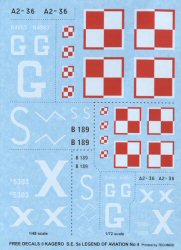
S.E.5a Book Review
By Michael Benolkin
| Date of Review | May 2005 | Title | S.E. 5a |
|---|---|---|---|
| Author | Edward Kocent-Zielinski | Publisher | Kagero |
| Published | 2005 | ISBN | 83-89088-61-4 |
| Format | 84 pages, softbound | MSRP (USD) | $21.95 |
Review
Kagero has been turning out some very interesting and well-researched monographs on many subjects which have not been previously adequately covered.
In this publication, the author provides a nice look into the Royal Aircraft Factory's SE.5a. The story begins with the political situation in Europe since the turn of the century (the 20th that is) and overlays the fledgling technology of flight into the picture.
At this point in history, the tranistion from radial engines to liquid-cooled engines was beginning. Why? Have you noticed how simple looking a WW1 radial engine appears compared to a WW2 or later radial engine? The WW2 engine has all sorts of pumps and generators hanging off the back of the engine. In WW2, the engine was mounted to the firewall and the propeller to the crank shaft.
In WW1, the crank shaft was bolted to the firewall and the propeller to the engine block! This resulted in the engine spinning at the same RPM as the propeller, acting as a flywheel and providing its own cooling through the motion. Even lubrication was simple as the oil was forced by centrifigal motion out into the cylinders. The downside to this is torque. In smaller engines, this was managable, but above 200 horsepower, the torque became a serious problem, hence the move to liquid cooled engines where the only thing spinning was the propeller itself.
The author does a nice job of putting this pivitol period of flight into perspective. The coverage includes:
 |
 |
- Introduction
- The Origin of the British Air Force
- The Genesis of the Design
- The Powerplant Issues
- The Prototypes
- Manufacturing and Production, Licenses and Assembly
- Powerplants of Production, Licenses
- Equipment
- Armament and its Variants
- Attempts to Develop the Construction, Tests
- S.E.5a Fighter Plane, Combat Usage
- Contemporary Replicas and Museum Aircraft
- Painting and Marking
- Epilog
In addition to the historical aspects of this title, presented in both Polish and English, there are numerous three view diagrams of the various configurations of the S.E.5a and many color profiles as well. In fact, a sheet of Techmod decals is also provided with the markings of selected color profiles in both 1/72 and 1/48 scale.
The aviation historian and modeler alike will want to add this to their reference libraries - especially considering the VERY reasonable retail price!
This title is highly recommended!







